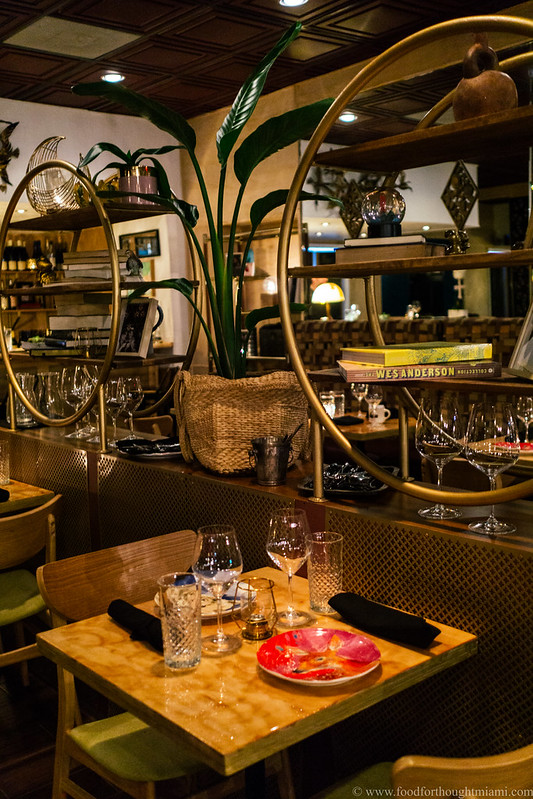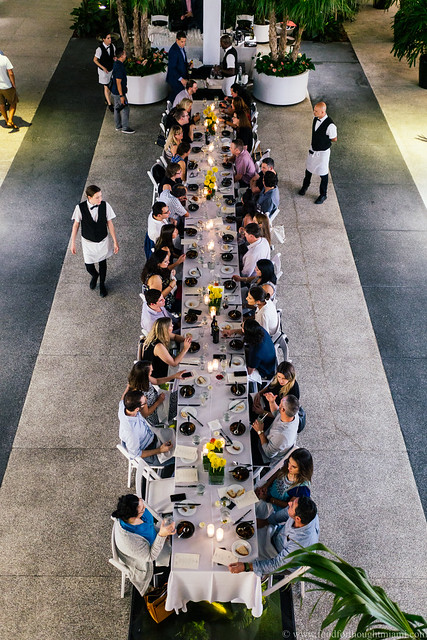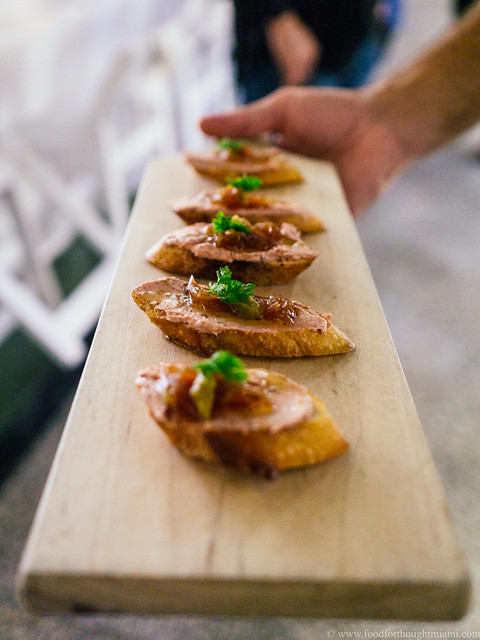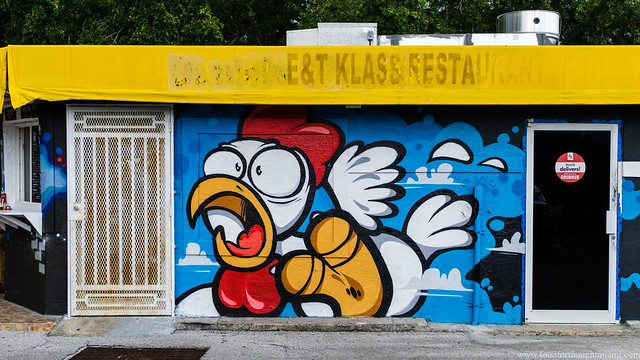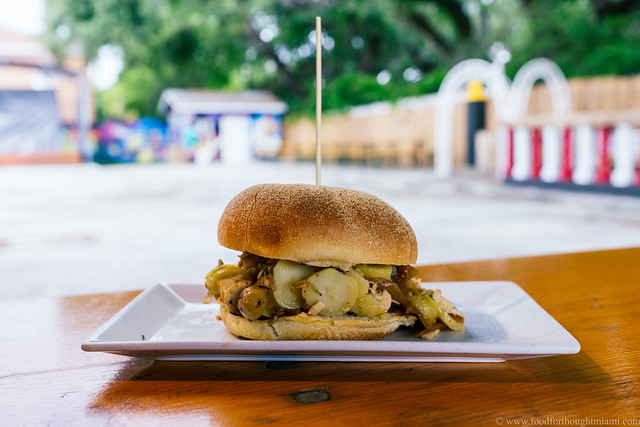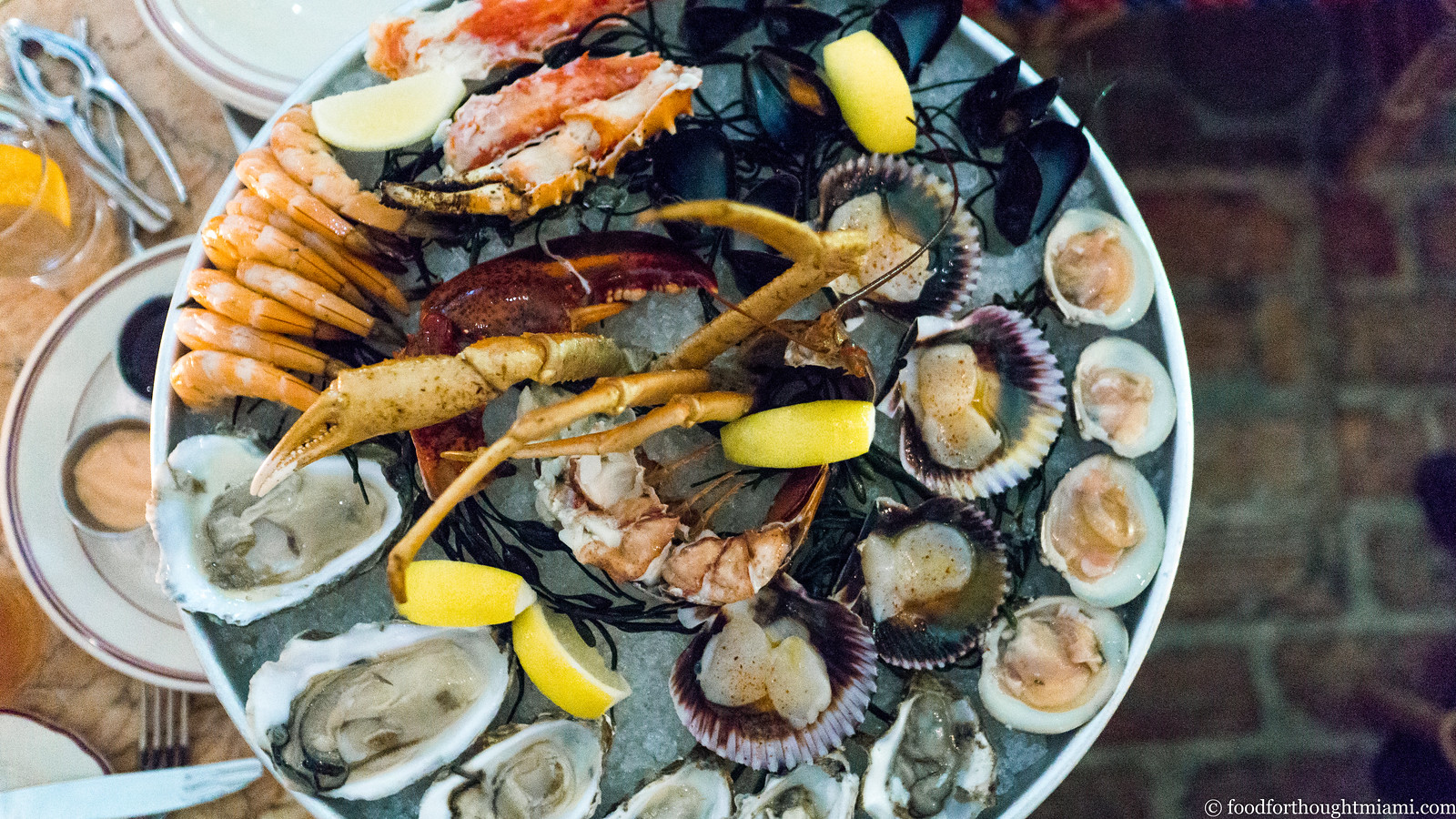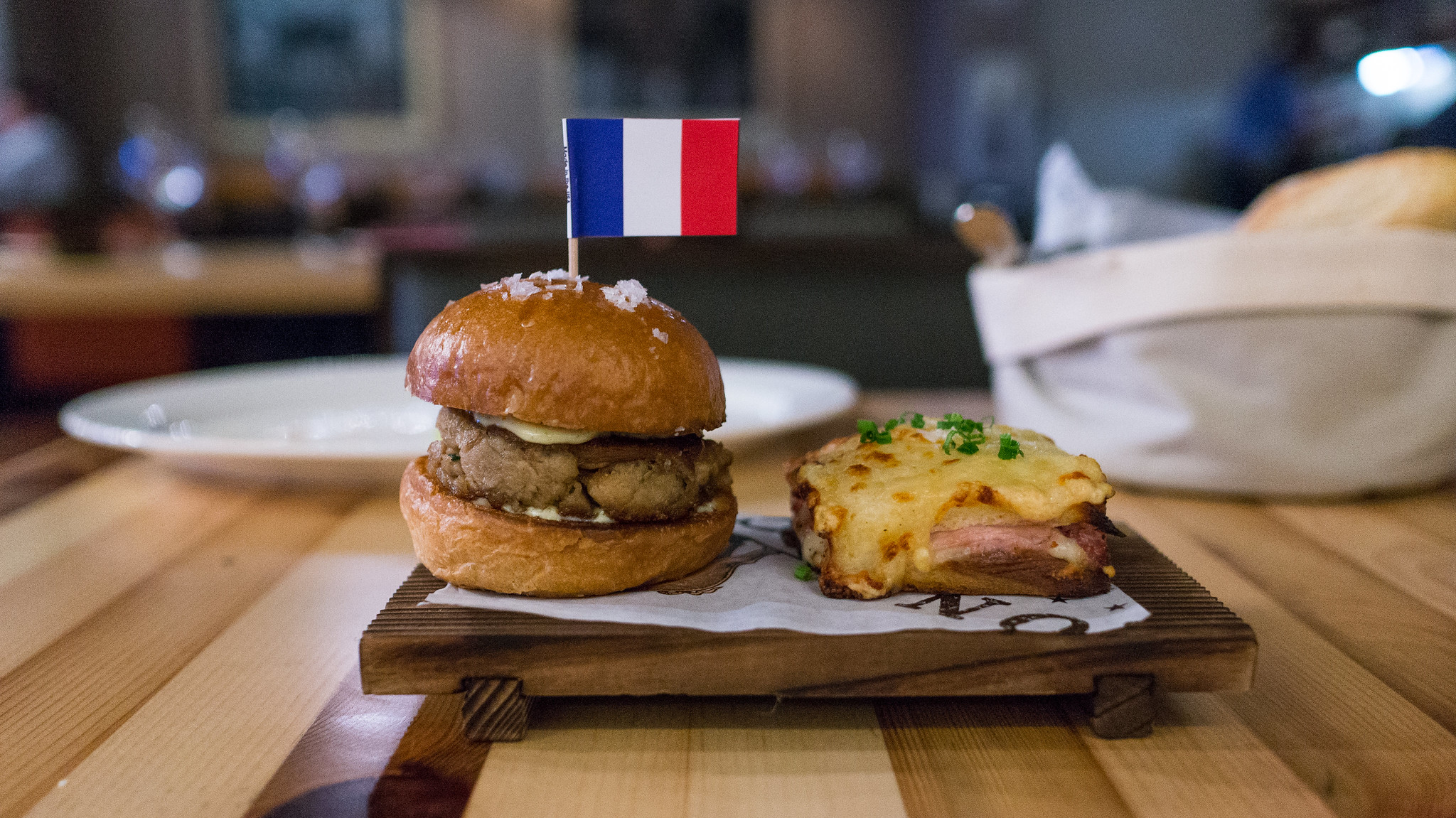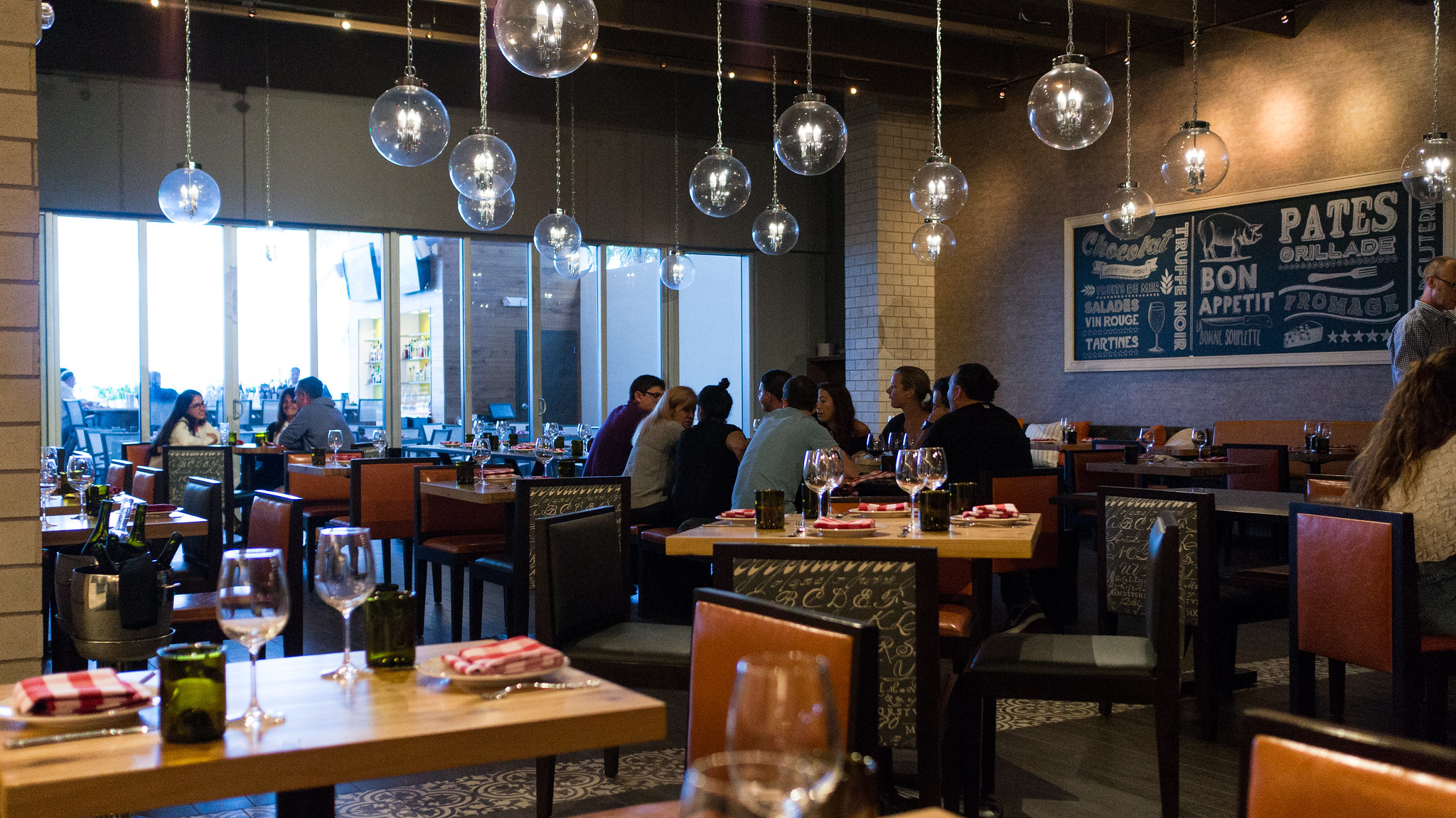[Sorry, this restaurant has closed]

The original
Au Pied de Cochon was opened in Paris shortly after the conclusion of World War II. Its owner was a pork butcher in Les Halles market, who wanted someplace to feed his staff when they came off their shifts. Since that was often early in the morning, the restaurant was open 24 hours a day. The restaurant endeavored to serve all of Paris' social classes, from aristocrats to butchers, with simple traditional French fare. Though Les Halles market has since been moved to the outskirts of Paris, Au Pied de Cochon remains, and supposedly has never closed its doors (indeed, the story is that there are no keys).
The Miami
Au Pied de Cochon just opened its doors this past Friday evening, in an old Art Deco building a block down the street from
Joe's Stone Crab. Mrs. F tells me this was a pretty decrepit building previously, and since I don't remember it, I have to believe her. It looks quite nice from the street now, and inside it's done up in typical Parisian brasserie style, with long banquettes with brass-railed glass partitions and lots of red leather on the seating surfaces. It's a somewhat peculiar layout - some might say cozy, others slightly claustrophobic. The main dining room space is sort of chopped up by a long banquette, there is a large curved bar in the middle and directly across from it a big seafood case stacked with oysters, lobsters, crabs and big head-on shrimp, and then more seating to the far side of the bar. Piggie motifs abound, from the pink pig vases on the tables to the pig imprints around the bar to the murals painted on the walls.
When we arrived early Saturday evening the staff (which is a small army) were still getting briefed and ready for service, though there were a couple tables already being seated. We settled in at the bar, where they had a short list of wines by the glass (they plan to expand it) and, surprisingly, no cocktails menu. Since this is de rigeur on South Beach these days (along with the $15+ price tags), I'm sure it will come soon. Meanwhile, Campari and soda and a Makers' Mark old-fashioned were about $10 per. It was only after I'd ordered my drink that I saw them setting up an old-fashioned absinthe drip on the bar.
The menu reads like a lengthy greatest hits list of French brasserie cuisine - the well-stocked seafood bar (with items available either by the piece or in plateaus of various degrees of extravagance), terrine of foie gras, escargots, onion soup gratinée, steak tartare, bouillabaisse, duck confit, braised veal cheek, rack of lamb, several prime aged steaks ... and making a decision was not easy. Even though I've got no French roots and indeed only spent very limited time in France, there's something oddly reassuring and comforting about this kind of traditional line-up. Mrs. F stuck with apps and went with a smoked salmon platter, followed by steamed mussels; I had the "Perigord salad," followed by the namesake pig's trotter.
Before our appetizers were delivered, we were each brought a nice, warm, crusty baguette, tucked into a little wax paper bag, along with a little ramekin of creamy salted butter. So far so good. The Perigord salad was a garden variety mix of soft-leafed lettuces, with slivers of smoked magret (duck breast), several croutons topped with foie gras, toasted nuts, and grapes, dressed in a walnut oil vinaigrette. This is how to get me to eat a salad. They were very generous with the smoked duck and foie croutons (about five long thin slices of toasted brioche, topped with thin slices of foie gras terrine). Unfortunately, some tomatoes that someone had gone to the trouble of fileting (cutting off the seed pod and leaving just the "flesh") were unripe and rock hard. It could have stood some perkier lettuce as well. I'm also partial to the traditional addition of green beans, but that's just a matter of personal preference.
The smoked salmon appetizer was brought out on a long narrow platter and looked like it was practically an entire side of salmon, served with the traditional accompaniments of chopped hard-cooked egg yolk and white, capers, and diced onion, along with a couple of blini. As Mrs. F was starting to dig in, one of the service staff was unhappy with how she was going about it and offered to "prepare" it for her; intrigued, Mrs. F accepted his offer, and he set up a tray next to our table and dressed the salmon with all of its accoutrements, a charming gesture. It was good salmon and a remarkably generous portion, though the blini were unusually fat and doughy, almost more like crumpets.
Mrs. F's steamed Prince Edward Island mussels, done simply in white wine and herbs, were again a massive portion for an appetizer, brought out in a big cast-iron pot. This seemed like a 1-kilo serving, and the mollusks were fresh and briney, though I prefer the daintier Mediterranean mussels to the fatter PEI's.
The pièce de résistance was the namesake pig's trotter, again a massive portion including not just the foot but pretty much the entire next joint of shank as well, given a very light coating of bread crumb, and laden with all the slightly mysterious textures of which pig is capable - crispy skin, tender shreds-with-a-fork meat, rich fat, gooey gelatinous bits. This is not for anyone who doesn't like to work some for their dinner, as it requires a good bit of picking among various knuckle-bones and other inedible bits, but for aficionados of the porcine, it's all worth it. It also is not for those seeking a lean, low-fat piece of pork tenderloin. Let me put it this way - when a dip in the béarnaise sauce (just slightly overthick in texture, but nicely spiked with tarragon vinegar and herbs)
cuts the richness of a dish, that's a bit of a heavy meal. I came nowhere close to finishing this, but happily brought it home and chopped up the remaining meat and other bits to have with some eggs and toast this morning. I wonder if there's any chance they will bring to Miami
La Tentation de Saint-Antoine, a pigalicious fest of trotter, snout, ear and tail served at the original Parisian outpost.
The accompanying fries were a bit skinnier than I'm accustomed to at French and Belgian places, and also a bit soggier. These could use some refinement, though Mrs. F and I still managed to finish most of them off (they were awfully good dipped in the béarnaise).
Though we didn't need anything more, I felt obligated to try a dessert, and we split a crème brûlée. Again, this was not an easy choice, with lots of other French classics on the menu - ile flottante, crêpes flambeed with Grand Marnier, warm chocolate timable, apple tart, Grand Marnier souffle ... I'm certainly glad we ordered only one dessert, as this was a massive portion - usually served in a small ramekin, this crème brûlée came in something more akin to a trough, nearly a foot across. The burnt sugar topping was nicely crispy, but the custard base was almost too soft and quivery, feeling slightly underdone.
The wine selections were fairly limited but decent, with about 8 bubblies, a few Rosés, about 15 whites (with one French representative from each of Burgundy, Bordeaux, Rhône, Loire and Alsace and the remainder from the rest of the globe) and about 30 reds (roughly half from France, and those mostly Bordeaux and Rhône). Prices range from $30s to upwards of $100 and most markups appear to be in the range of a 2x to 2.5x retail. One frustration is that vintages are not listed on the menu, though I was pleasantly surprised to see that the Vidal-Fleury Gigondas we ordered was a 2000 with some bottle age on it (this appears to be a late release from the winery).
Service belied both South Beach and French stereotypes, and was warm, friendly, solicitous and helpful. Everyone there seemed to know the menu well, and was eager to make recommendations. For only having been open one day, they seemed to be running pretty smoothly, and we had no notable service issues. There's also many old-school French touches like tableside preparations on several of the dishes - I felt a rush of heat on the back of my neck as the veal kidneys in mustard sauce were prepared for the next table over.
The food was not perfect, but it was good and showed promise, and a good French brasserie is always a nice thing to have around, especially one that is open 24 hours a day. But there is a bit of a disconnect between the quality and sophistication of the fare at Au Pied de Cochon and the prices in some instances. The Perigord salad seemed perfectly fair at $15.50, but $27.50 for a terrine of foie gras appetizer seems awfully steep even for this luxe ingredient (though I was sorely tempted by the $29 foie gras and apple tarte tatin appetizer, I refrained both due to the price and in anticipation of my trotter entree). A pork chop can be had for $21.50, but a Kobe beef burger is $25, duck leg confit is $27, the braised veal cheek is $33, and the steaks (all USDA prime and aged 21-28 days) are all in the $40s. On the other hand, the portions on some of the other items (like Mrs. F's $14.50 mussel appetizer or the gargantuan crème brûlée for only $7) made them seem like incredible bargains.
I'd just as soon see them work on the portion sizes and smooth out the menu pricing all around, rather than have such extremes. It's possible to have a reasonably priced meal here, but it can also quickly become quite expensive. While it's nice and cozy, it is simply not a fancy enough place to feel like you're having a $100 meal; and at some of these rates, the Miami Au Pied de Cochon is going to have a difficult time drawing in the butchers. But if they can straighten out some of the food miscues and pricing oddities, and make this more of an "everyday" rather than "special occasion" type of place, I suspect it will do quite well with the South Beach crowd.
Au Pied de Cochon
81 Washington Avenue
Miami Beach, FL 33139
305.674.1844


